|
The Prieuré and Gurdjieff's Grave
June 18
Gurdjieff vowed never to do anything in an ordinary way, and the fact that his gravesite is not ordinary in any respect is in complete accordance. Far exceeding the profound finale of his interment, was the depth to which he carried his vow.
All our previous experience with his work, had led us to assume that his final message would be characteristic of a commonly held view regarding his approach: heavy-handed. We expected to find a jolt-laden artifact, a reminder to everyone of their unconscious, lackadaisical efforts toward being-partkdolg-duty (Helping God).
There was nothing of the kind; no jolt, no zap, no shaktipat, no corn-crushing, no message. There is such a fineness and evenness: consciousness, undifferentiated (no Self, no I, no concentration of substantiality). How could a being-conscious-in-this-way have maintained any effort toward independently existing I-hood? Is consciousness without a subject or an object in any way dependent upon I-hood?... Even now this question is being left open in order that a continuing growth in comprehension may develop...
It was rather strange how we got here. After visiting the beautiful little gothic church at Melun, we decided to try to find the Prieuré. We didn't know where or whether it even existed anymore. After all, it was due almost solely to Gurdjieff's writings that there is any real information on the transmission of “objective” knowledge through artifacts. Much of our own research into art had been inspired by his work. The fact that he lived in France for over 25 years would surely indicate that he had also explored the gothic cathedrals. The chapter, “France”, is one of the longest in Beelzebub's Tales. But that's diverging from the story at hand.
We arrived in the Fontainebleau-Avon train station rather late. It was raining. We didn't know where to look, so we asked someone (who'd heard of a Prieuré), but it didn't sound like the one we were looking for. At least it was a start. Walking toward Avon we bumped into an older man out for a walk, who like us also wasn't from here, but somehow miraculously he had heard of Gurdjieff, although he didn't know anything about where the Prieuré might be. He assured us that if we were very lucky, we would find G (or at least his grave). So we went to a gas-station across the street. No one had heard of Gurdjieff but they had heard of a Prieuré, even though it was now a senior citizens home. One of the customers volunteered to drive us there, and within half an hour of our arrival in Avon, we were standing at the gate entrance to the Prieuré – the one mentioned in all the books on Gurdjieff.
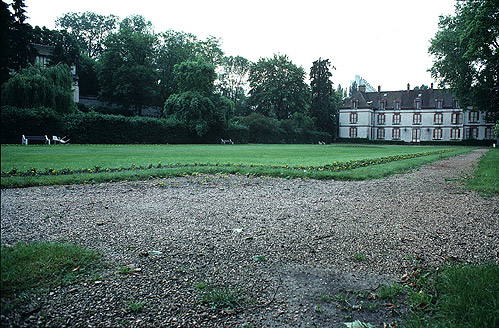
It was somewhat surreal to be viewing the empty shell of what had once been, according to all accounts, “an esoteric school” headquarters. The rain had changed to a drizzle and this hanging atmosphere gave the place an added impression of deadness, further muting any evidence of the work that had once transpired here. Very neat and trim, yet shrouded by a gossamer of empty melancholy.
The Prieuré and the residences that G and his students had lived in were derelict, and were used for storing junk (since converted into apartments). Not even a ghost remained. We met a nurse who directed us to the newly built seniors' residence. On speaking to the supervisor in charge, we were informed of an office in the building which contained some G memorabilia. We asked if we might take a photo, which we did. There were two large plaques behind plexi-glass with various newspaper articles in French, about G and his “mysterious” school. One picture showed a tombstone, which later was recognized to be G's.
Noticing that we were interested in the G material, a caretaker took us by the arm and ceremoniously led us outside again to reveal a corrugated tin covering over a dug out underground room located near a corner of the property, which he cryptically described in a hushed tone as "une grotte". His facial and body language communicated his feelings that something mysterious and secret had transpired in this hidden underground sanctuary. There was little left in the now muddy chamber except a place where a small number of people may have been able to squeeze in to sit. A ladder would have been needed for entering and exiting. Besides the possibility that it was an underground sauna, Gurdjieff had probably used this space for very private teaching situations or for meditation retreats. There's nothing more grounding to meditation and active mentation than to be actually located within the earth - such as in a cavern, cave or "grotto" like this. It is no wonder that since time immemorial these types of formations have been and continue to be actively used by serious spiritual seekers.
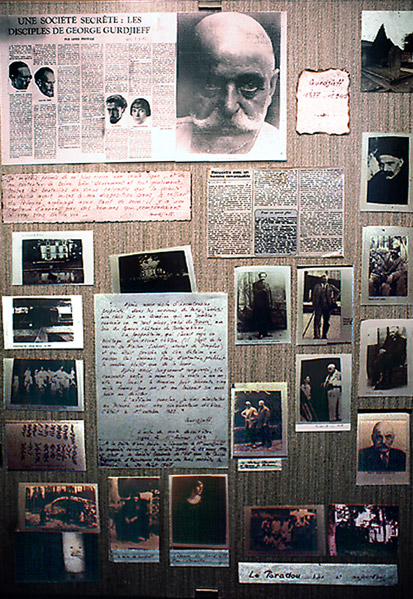
Following this short interlude, we asked for directions to G's grave and were told that the site in Avon was quite a distance. But since we were here anyway, why not go for it! After arranging to leave our photographic equipment case in the waiting room downstairs (intending to pick it up on our return), we left for the cemetery.
It was about 4 km. to walk and we had only a general idea of the cemetery's location. Being after 7 p.m. the buses were no longer running. As we didn't know where to go, we asked a fellow in a van where the cemetery was. Noticing we didn't speak much French, and out of compassion it seems, instead of trying to explain it to us, he drove us there. Thanking him, we turned to enter and found the gates locked. Resolute, we made some noise and the caretaker eventually came out. We tried to explain to him that we were from Canada and wished to visit Gurdjieff's tomb. Upon hearing this, he gave an “I should have known” smile and waved us in the direction of that end of the cemetery, saying, “It's over there”, or something to that effect, and went back inside.
Although there were thousands and thousands of headstones “over there”, an undisturbed openness filled our steps as we started to walk. And when we came to Katherine Mansfield's gravestone with the misspelled epitaph, the next thing we saw was G's distinctive grave site. Having worked in cemeteries for many years there'd been occasion to see hundreds of thousands of tombstones and gravemarkers. Yet, nothing could have prepared one for the impact of what we saw and felt and sensed and knew about Gurdjieff, then and there. This series of understandings wasn't dependent upon the existence of some material artifact at some particular space/time coordinate. The presence or absence of a “work” cadaver had nothing to do with the clarity of the insights. Rather, the profound apperception streamed from direct Being relaxation into unavoidable universal undisruptedness. Concurrently, a feeling arose akin to the experience of unexpectedly bumping into one's oldest and dearest of friends – whom one hasn't seen or heard from for eons. A palpable joy, excitement, gratitude and brightness seemed to infuse everything. Whether being present at the gravesite helped to trigger these following realizations isn't important. It undoubtedly didn't hinder them.
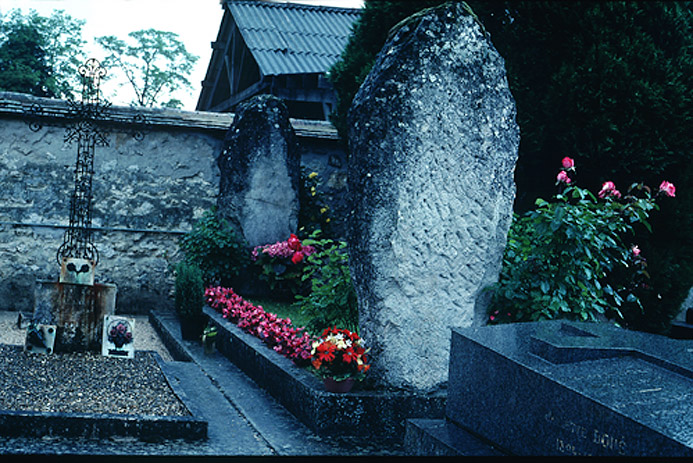
Amidst all the uniform dead greyness of the local crowd, G's monument stood out like some alien species. How can it be described? Somehow or other, we were half-expecting to find somebody or other, “GURDJIEFF”, with something strange or mystical inscribed on his gravemarker. Instead all you find is nothing. No name. No inscription. Yet you know beyond certainty that this is it. Everyone else has left some platitude or other. G has left nothing. Nothing but two tombstones instead of one. In reality, these standing stones are more like temple pylons, as far from being tombstones as the ocean is from ether. And though they are modern, their presence is ancient, so ancient that they might have been taken from Stonehenge or another site of even more remote antiquity.
While everyone else in the cemetery has left markers to sustain some “memory” of subjective importance, “Gurdjieff” whoever he was or is, has left something much more real. And in this reality, we come face to face with the real Gurdjieff, the “unknown” G. Not the teacher, not some magician, but something far more immediate and direct. And in this realness is recognized the fact that nothing that was ever said about Gurdjieff by others or himself has been real. Perhaps even he didn't know until the very end. The end?!
But however his last realizations occurred, this final reminder to any who might yet understand may be the most eloquent and essential of the work he did. It is not a reminder of some ultimate end and resting place for some “body”. There isn't even a hint of a shadow of the conventional floundering about death and the “after-life”. Instead, the unmistakable sense of continuity for one who merely continued working after organic terminus. No wondering, no after-thought. Simply doing one's work. In death as in life; seamless and uniform...
The precision and care with which the head and footstones are aligned (like the two prongs of a tuning fork or the +/- terminals of an electric circuit) cannot go unnoticed nor unmentioned. His senior students did an exemplary job. This attention to detail reflects one of the aspects of the teaching G labored so long and hard for. The grave is also a poignant reminder of the obvious; that the “dead body” can only appear between two poles or extremes. The implication is that if any kind of extreme is knowable, this will indicate the presence of death. In the Ramayana, Death is called The Seer of Distinction. What applies to physical phenomena equally applies to all modalities of existence as well, including the level of ideas, spirituality and beyond.
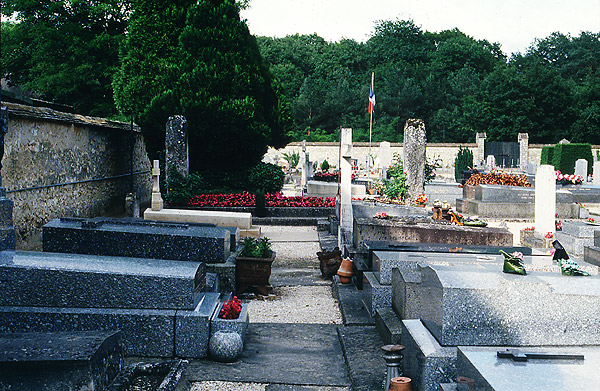
In the teachings that Gurdjieff transmitted, he went to great lengths to establish that humanity's ideas of some sort of absolute duality - of "good" and "evil" - were nothing but fantastic childish delusions. In Beelzebub's Tales to His Grandson, he emphatically insists that all esoteric religious, scientific, artistic and technological teachings originally emanated from one unified source. The stories throughout the Tales deal with the many attempts of various "messengers", to reverse the results of the atrophying spiritual fragmentation brought about by this particularly pernicious and widespread mental illness known as dualism. Therefore, it is most ironic that in mapping out the principle of an “Objective Reality” as the basis for all that is, G and all those who follow his line of reasoning may have produced just such an apparently insurmountable duality as an unconscious consequence of this perspective. How? From the assumption of an "Objective Reality" arises the necessity to have a “God Almighty” who is totally independent of “all this”, but who is incapable of doing anything other than creating the first impulse for generating the universe. According to this view, following the originating primal impulse, only “Law” functions. “Law” reciprocally prevents “God” from doing anything whatsoever except watching God's body, “the megalocosmos”, attempt to come to completion through the functioning of Law. From this viewpoint of a God “apart” from creation the bridge between God and the universe will never realize an end or completion, because part of this “universe” is impermanent while part of it is eternal. By their very nature, these two extremes cannot merge. Thus, in order to resolve this contradiction within God's unbroken unity the impermanent and the eternal are retracted into a single principle, Being, which apparently vanishes and re-emerges in a new creation. However, this retraction and re-emergence itself then takes on the nature of transitoriness by its oscillation, variation and fluctuation. At the same moment it is eternal in terms of a never-ending series of possible creations. Because the very retraction of the transitory into the eternal, and the eternal into God has been necessitated by the fulfillment of the Law of Creation which was itself generated by the Creation of Law, God now finds God within a cycle characteristically known as endlessness. But this endlessness then becomes a Karmic extreme in the sense that once in it, “Our Endlessness” cannot get “out” except by Dharmically transforming into a “Greater God”, ad transcendeum... But because endlessness has now become an absolute necessity, this condition is exactly the thing that creates a “dead body”; the clinging to or the inability to let go of, an extreme. So the resulting extreme of having a view about an absolute will end in some other extreme, such as “endlessness”. No matter how much is put in between to fill the “gap”, no matter how many eternal hierarchies are bridged, no matter how many infinite stairways and ladders are climbed, there is still a distinction. To be a slave of endlessness is still to be a slave. To endlessly seek the unknown is still to be necessitated by the fascination for/obsession with the perpetual motion of the seeking. Is this what “God” really wishes? Does “God” really require an endless flow of megalocosmic bodies (even if Divine Ones) to bridge the gap of eternal aloneness? Or does the fixation on an Absolute simply and inescapably result in this endless flow of becoming alive and dead, dead and alive?
How does the existence of a teaching based on such assumptions affect the life of those who are its unconscious recipients? If the seeds of "death" are inherent at the peak of the pyramid, how much moreso at the base? Does ascension beyond the peak only create an equally powerful descension? Is the idea of an esoteric/exoteric, inner/outer dichotomy only another death mask? If this idea has somehow unconsciously fixated itself in the mindstuff of Earth humanity, thereby generating a tendency for those with this implant, to abstract, polarize and tenaciously cling to the identity-view of a locally experienced reality which is "apart" from universal reality, it does not mean that the consequent appearance of “dead bodies” is anything other than one of the immediately demonstrated results of this projected fixation, does it? And even though "merciless Time", “higher being bodies” and “cosmic sacred individuals” are glamorous attractions, the over-all result is that a “residue” or “shit” still comes from such a viewpoint, notwithstanding the possibility that subjectively speaking, an infinite series of transformations proceed from the deposit. The perceived appearance of "separation" generates the appearance of "Time" which produces the appearance of a “dead body” which through such habitual identification with "separation" becomes a dead body, which then necessitates the appearance of somehow re-membering One Self, before there was ever any "separation" so that there will no longer be "death" – and on and on... producing ever more and more of the same; even if the "scale" of “relationship” is between the “Absolute” and “Creation”. But because it's all just an appearance, there is no time between life and death, and therefore no death in reality – which also precludes the existence of that which dies. Thus death is only the apparent break in the uniformity. This apparency is called duality. The need to escape is that which seems to die. Yet nothing can escape. Nothing needs escape. As long as there's a need to escape, there is always something or someone chasing. Eventually this running turns into a search, a quest for finding out who or what is driving or chasing one. For those who need to escape, this is what becomes translated into the “search for God” or "the search for truth".
The “path” through which one “finds God/Truth” is determined and specifically defined by any unconsciously existing being assumption(s). As an example, one such assumption posits the Absolute's Real Condition as that of an Eternally Suffering Being that suffers due to its inextricable union with the robot-like corpse of its own creation, which occasionally flickers to life; i.e. changes into something “new” beyond an eternally repeated pattern. It is up to the Creation to bring itself back to Divine Life through "conscious work efforts" that in some way transcend even the Absolute. What isn't exactly clear is how and what turned the "Creation" into a robot-like corpse in the first place. In another, the Creator is necessitated to dodge the inadvertent consequences that the creation of Time has upon the Divine World, leaving the Creation to handle any other unforseen eventualities, Oops! No matter how the basic assumption is stated, several unvarying characteristics are recognizable. Besides being almost exclusively propagated by males, the above views, along with some less extreme variations are all nonetheless viewable by only a very few individuals; those “outside” the view's “what is real and what needs to be done" – "the other(s)", are not working, thereby invariably leading the view's practitioners to the conclusion that “work” is an exclusive endeavor, and certainly not for everyone; which in turn can generate an unfortunate self-reinforcing cycle of belief whereby the members genuinely feel that They and They Alone are part of and have access to something that is absolutely unique, some "secret key", above and beyond all other teachings/teachers, and certainly beyond ordinary existence. Imagine what would happen if various sects and schisms formed among a group or groups of beings holding on to such assumptions, each believing to be exclusively privy to the "real" teaching, the "real" truth... What would be the result if large populations, cultures, civilizations - unconsciously held such assumptions about their fellow beings – each group imagining itself as the identity of "truth", while all else is "other"?
At a manifest level, the preliminary way in which such closed circles of viewers attempt to apperceive the “Absolute” is by being “nothing”, yet somewhere in translation, this nothing becomes “relational” to the Absolute and thus to "creation". Can one or a few know the Absolute if all the rest are unconscious, or is the view itself determined by and reflexive of the essential assumption through which the view is realized? Regardless of how these results of searching try to “help” to rectify or sustain the apparency of duality, the very assumption upon which all such views depend only perpetuates the apparent problem, or its neverending solution. This latter "method" has the "individual" forever cutting themselves off from their deepest essential love, Union with "the Absolute", such that there is forever yearning, but never the true possibilty of "completion", which supposedly helps the Absolute realize Orders of Absoluteness that would never have been possible otherwise. The impulse to escape has now been transformed into “helping”, but at the cost of “objectifying” the apparent separation between God and Creation. If the purpose of this method is to establish utter indifference to any result, then of what relevance can "helping" be? And so on....
All that can be done by anyone who holds to a fixed reality (spiritual or otherwise) as being ultimate, is to continue penetrating deeper, deeper, and yet deeper in consciousness... until it is recognized that there is not a one. Not a not. Nothing. Without something or everything to compare itself to. Nothing before nothing was ever invented. Nothing after nothing completely and utterly subsides. Nothing. In the Face of Nothing, Nothing Is Absolute/Absolute Is Nothing...
The Silence of unbroken Presence at G's gravesite totally transcends any of his previously issued injunctions – like relegating most of mankind to governance by some sort of absolute duality - the consequence of which is the discarding of these unfortunates into the cosmic "too late for completion" bin, through which these spiritual essences will all be dissolved into their primal components and recycled. Yikes! This idea's continuation (as projected by the grave ensemble) and its accompanying need to redeem the "debt" through self-sacrificial payment are ultimately irrelevant. The underlying intensity of consciousness beneath the expression relinquishes all striving and necessity to be and do. “Unto and beyond death, beyond anything”, are nothing but absurdity. There Is No Fear Here.
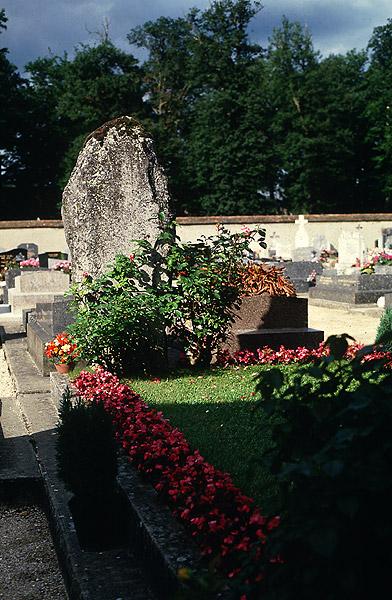
Although the idosyncratic abuse to which G subjected his body (which may have lent a definite severity to the “method” he employed) was totally unwarranted except for him in particular, at least in order to arrive at the realization which allowed setting up the grave site space, some of these excesses now seem to be one of the attractions that draw people to his “work” legend. In the final year of G's life, there was a huge rush to pass on and preserve as many of his methods and ideas as was possible... Yet if anyone would only pay heed to the “last” thing he left and his final words, “I leave you all in one fine mess”, they might yet come around to comprehending that the entirety of his work was never completely finished, and that his realization of this in his last days, also may have radically altered his own being conscious of what “work” really is. Nothing. (This is not a nihilistic reference, but is meant in a transcendently immanent way.) The joke of it is that if nothing is true, then what was there to complete or be incomplete in the first place? Le dernier rire est toujours à nous-mêmes, n'est pas?
And in one more comic twist to this punchline, it's been suggested that Gurdjieff's corpse isn't even buried at the designated gravesite, but has been deposited in some undisclosed plot beside his beloved but equally deceased wife and mother. Apparently, this location is known only to a “select few”. If this is actually the case, the only question for doing such a thing would be, “Why?” Like so many things Gurdjieffian, truth and absurdity are inexorably intertwined. The uncertainty of Gurdjieff's birth and the real particularities of his life, even carries over into his death. Heisenberg would have loved him, if only to see his Uncertainty Principle manifested in the Newtonian universe! Gurdjieff was never averse to a great joke at his own expense. It reminds one of the story of Mullah Nassr Eddin's donkey. After several decades of companionship and service, Mullah's dear old friend finally died. Mullah, overcome with gratitude and love, built a memorial mound, over which he laid flowers and other mementos of their friendship. For weeks he prayed and kept vigil. Seeing this, passers-by assumed that this must be the location of some great saint's shrine. Thereafter, the Donkey's final resting place became a site of religious pilgrimage, at which His many saintly attributes and powers were invoked by the faithful. Apparently their prayers were answered about as efficaciously as at any other Saint's tomb... And it is true, that between the head-and-footstones at Gurdjieff's memorial, there is indeed enough room, not only to bury a donkey but the donkey-cart and driver as well. And speaking of donkeys - Gurdjieff's last words spoken were, "Bravo America...". If any of his students had been alert to this clue, as well as being competently trained in tracking a Being through post-Terminus states into Conscious Rebirth, they would have immediately known that their Master would be seeking Incarnation as Someone in America; a place better known among those who know, as The Land of Donkeys! Blessings Be upon all those who can give up their Graveness to Be the Laughter of Existence.
For the benefit of all and everything (as he understood it to be), Gurdjieff set about to do the impossible; to consciously awaken a species, which for the most part would rather stay somnambulant, and will reflexively do anything in its power to remain in that comatose state. Anyone who even considers such an undertaking is deserving of genuine gratitude. So-o-o, maybe in spite of the shortcomings of the systems that he employed, and notwithstanding that he left many “loose ends” behind, this final reminder that the Work and even its ultimate aim is Void, laid naked the love, compassion and the underlying sense of fun motivating everything he attempted, washing away all the accumulated bullshit around him. May it reach those who need it most.
Our return journey to the Prieuré was no less unusual. We got a lift in the pouring rain and were placed back at the entrance. By this time the gates had been locked. Leaping over the bars, it was discovered upon arriving there that the reception area was also locked and deserted, with our camera gear inside. Looking around, a light was sighted on the first storey of the residence. Going toward it, an open French door gave hope of contacting someone about this situation. An old woman gave the invitation to come through. On looking back, the number 222 was seen to be on her door. We went to the night staff's quarters and our equipment was retrieved. Thereafter we made short shrift of the walk back to the station....
Since then we've paid several more visits to G's grave. Each has been enlighteningly instructive. In the words of a friend, “There are no escapes from life, only exits and entrances.”
|





